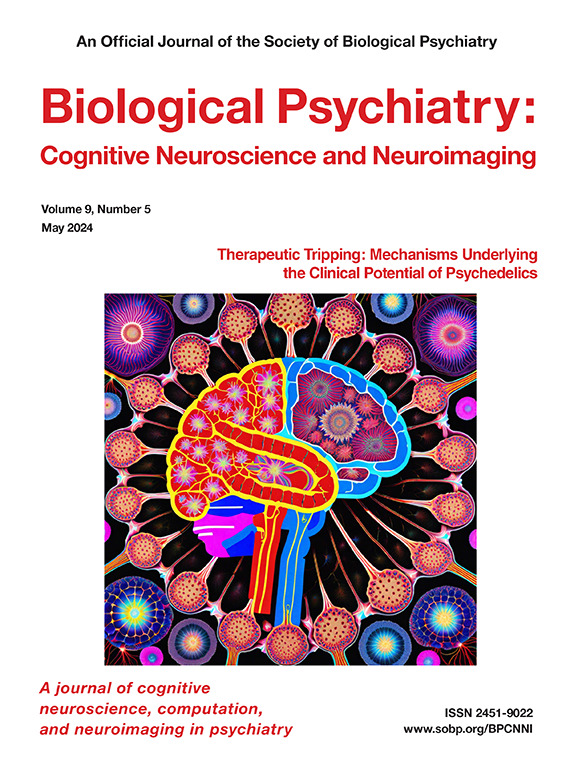Delusional Unreality and Predictive Processing
IF 4.8
2区 医学
Q1 NEUROSCIENCES
Biological Psychiatry-Cognitive Neuroscience and Neuroimaging
Pub Date : 2025-07-01
DOI:10.1016/j.bpsc.2024.12.006
引用次数: 0
Abstract
Background
Phenomenological psychopathologists have recently highlighted how people with delusions experience multiple realities (delusional and nondelusional) and have suggested that this double bookkeeping cannot be explained via predictive processing. Here, we present data from Kamin blocking and extinction learning that show how predictive processing might, in principle, explain a pervasive sense of dual reality.
Methods
This cross-sectional study involved 3 participant groups: patients with schizophrenia (SZ) (n = 42), healthy participants with elevated esoteric beliefs (EEBs) (clairaudient psychics) (n = 31), and healthy control participants (HCs) with neither illness nor significant delusional ideation (n = 62). We examined belief formation using a Kamin blocking causal learning task with extinction and delusions with the 40-item Peters Delusion Inventory, specifically the unreality item “Do things around you ever feel unreal, as though it was all part of an experiment?” as a proxy for unreality experiences and beliefs. A clinician also assessed symptoms with a structured clinical interview.
Results
Some people with SZ did not report a sense of unreality, and some people with elevated esoteric beliefs (but no psychotic illness) reported unreality experiences. No HCs reported them (despite reporting other delusion-like beliefs). Unreality experiences in clinical delusions and nonclinical delusion-like beliefs were associated with different types of aberrant prediction error processing.
Conclusions
These data suggest how predictive processing may explain the sense of unreality. They indicate that different prediction error dysfunctions are associated with delusions with different contents. In this case, we have used predictive processing to address a salient issue raised by our phenomenological colleagues, namely the impact of psychosis on experiences of and beliefs about reality.
妄想性非现实性和预测性处理。
背景:现象学精神病理学家最近强调了妄想患者如何经历多重现实(妄想和非妄想),并提出这种双重记账不能通过预测处理来解释。在这里,我们展示了来自卡明阻断和灭绝学习的数据,这些数据显示了预测处理在原则上如何解释普遍存在的双重现实感。方法:本横断面研究分为三个参与者组:精神分裂症患者(SZ;n=42),具有高深奥信仰的健康参与者(EEB;顺风耳心理学;N =31)和健康对照(无疾病或明显妄想,N =62)。我们用卡明阻断因果学习任务来检验信念的形成,用彼得斯错觉清单来检验错觉,其中有40个项目,特别是不真实的项目:“你周围的事情是否感觉不真实,就好像这是一个实验的一部分?”作为不真实经历和信念的代表。临床医生还通过结构化的临床访谈评估症状。结果:一些精神分裂症患者没有报告不真实的感觉,一些EEB患者(但没有精神病)报告了不真实的经历。没有高等法院支持他们(尽管支持其他类似妄想的信仰)。临床妄想和非临床妄想样信念中的不真实经历与不同类型的异常预测错误处理相关。结论:这些数据提示了预测处理如何解释不真实感。结果表明,不同的预测误差功能障碍与不同内容的妄想相关联。在这种情况下,我们使用预测处理来解决现象学同事提出的一个突出问题,即精神病对现实经验和信念的影响。
本文章由计算机程序翻译,如有差异,请以英文原文为准。
求助全文
约1分钟内获得全文
求助全文
来源期刊

Biological Psychiatry-Cognitive Neuroscience and Neuroimaging
Neuroscience-Biological Psychiatry
CiteScore
10.40
自引率
1.70%
发文量
247
审稿时长
30 days
期刊介绍:
Biological Psychiatry: Cognitive Neuroscience and Neuroimaging is an official journal of the Society for Biological Psychiatry, whose purpose is to promote excellence in scientific research and education in fields that investigate the nature, causes, mechanisms, and treatments of disorders of thought, emotion, or behavior. In accord with this mission, this peer-reviewed, rapid-publication, international journal focuses on studies using the tools and constructs of cognitive neuroscience, including the full range of non-invasive neuroimaging and human extra- and intracranial physiological recording methodologies. It publishes both basic and clinical studies, including those that incorporate genetic data, pharmacological challenges, and computational modeling approaches. The journal publishes novel results of original research which represent an important new lead or significant impact on the field. Reviews and commentaries that focus on topics of current research and interest are also encouraged.
 求助内容:
求助内容: 应助结果提醒方式:
应助结果提醒方式:


